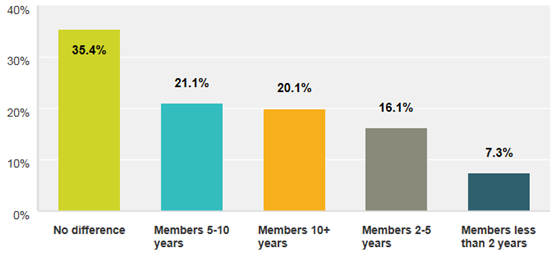How to Connect with the Next Gen — and the Gen After That

Your organization may be the No.1 source of information for your industry or profession. But, if you still think you have a lock on career advancement and professional education, you better check your combination. With LinkedIn’s recent acquisition of online learning company lynda.com, associations may be facing more competition than ever on the membership value front.
As my colleague Carrie McIntyre explains, LinkedIn and lynda.com are now committed to helping professionals improve their skills, accelerate their careers and integrate networking, jobs and educational content. As Carrie states, “In other words, the very things that associations have been doing for decades.”
![]()
Millennials will account for half of the nation’s workforce by 2020.
Our research shows most new and younger members aren’t highly engaged with your communications.
The tools and technologies may be different, but young people have the same insecurities and high hopes you did at that age.
Millennials want work that has meaning and ample opportunities to have their ideas heard.
Even with a growing economy and rapidly improving job market, career advancement topics are increasingly top of mind for association leaders, according to our annual Association Communication Benchmarking Study. For the first time in the four-year history of our study, “How-to/best practices” supplanted “Lobbying and advocacy” as the topic that association leaders believed was most important to their members. More than half of the 704 association leaders who responded to our study cited “How-to/Best Practices,” up from 49.6 percent in 2014. Meanwhile, coverage of lobbying and advocacy was cited by 45.7 percent of respondents, down from 52.1 percent 2014.
In fact, four of the top eight topics of importance to members had a career flavor. In addition to How-to/best practices:
- “Career/professional development,” was cited by 45.2 percent of respondents (up nearly four percentage points from 2014).
- “Statistics that help me do my job better,” was cited by nearly 31 percent of respondents (up five percentage points from 2014.
- “Networking for young professionals,” cited by 21 percent of respondents (up nearly five percentage points from 2014).
Get the picture?
Year-over-year change in career topics of importance to members
| 2014 | 2015 | % Change | |
| How-to/best practices | 49.6% | 50.4% | +0.9% |
| Career/professional development | 41.5% | 45.2% | +3.7% |
| Statistics that help me do my job better | 25.8% | 30.9% | +5.1% |
| Networking for young professionals | 16.6% | 21.1% | +4.5% |
Source: Association Adviser eNews and Naylor Association Solutions, LLC 2014-2015.
What’s more, our research indicates that newer and younger members are least likely to be engaging with member communications. This means you need to be more creative about how you connect with next-gen. For instance, only one in six respondents (16.1 percent) felt that 2-to-5 year members were the cohort “most engaged” with their association’s communication, and only one in 14 respondents (7.3 percent ) felt new members were the group most engaged.

N=627 Source: Association Adviser and Naylor Association Solutions 2015.
So, what does it take to engage your career-focused next-gen members?
“Provide meaningful and engaging work,” observed one association leader who responded to our survey. “This generation is looking to make a measurable impact during their involvement with associations/nonprofits.” Another respondent suggested matching them up with mentors and getting them involved in leadership. “Choose a couple of the most outspoken, well-liked young members and engage them in board activities,” suggested another survey respondent.
You also have to help your members gain the skills needed to compete in a “global-ready” workforce. As Daniel Obst, deputy vice president, international partnerships at the Institute of International Education (IIE), explains in today’s Corner Office profile, workers who don’t have international experience will increasingly find themselves at a disadvantage.
Meanwhile, research from the salesforce engagement platform Clearslide notes that nearly half of the workforce in 2020 will be composed of millennials (those currently 18 to 35 years old). That’s just five years away. As you might expect, Clearslide researchers consider millennials to be tech-savvy, socially connected, and more comfortable “job jumping” to find professional fulfillment. The way millennials evaluate job opportunities is very different from past generations. According to Clearslide’s report, “Although they require new levels of flexibility, office perks and management styles, the potential return on investment is enormous.”
The job-hopping component especially caught our attention here at Association Adviser. On one hand, the younger generation is considered a cohort of “non-joiners” and less loyal to employers and other formal organizations when they actually do join. At the same time, that makes next-gen more in need of professional networking, good job opportunities and continuing professional education — those are things that should be right in the typical association’s wheelhouse.
But, as any membership director can tell you, there’s no guarantee next-gen will look to your organization for those benefits. Thanks to social media and mobile technology, they come out of school with a much larger built-in network than previous generations did. Retaining and motivating millennials “is a continuous effort that is largely dependent on company culture,” the Clearslide report observed.
IIE’s Obst told us that every staffer, regardless of age or job title, is empowered to suggest ideas and have them taken seriously. “Again, that comes from my dot-com [days]. IIE’s workforce is fairly young and that kind of work environment is very important to millennials. Half of our staff has been here two years or less — they haven’t been beaten down by bureaucracy.”

While Clearslide’s research is oriented toward young people in sales careers, we asked millennials in non-sales careers if the findings applied to them. For instance, researchers concluded that millennials are looking for purpose at work, and they want a job that not only advances their career, but is also fulfilling on a day-to-day basis. Brianna Lawson, a young online marketing specialist at Naylor Association Solutions, said she feels most accomplished in her career when, at the end of the day, “I’m able to think of a moment where I provided my thoughts or ideas on a project and they were taken into account.”
According to Clearslide’s report, millennials also tend to approach their jobs with a “grass is greener” approach, which means they are unlikely to stick around if they don’t feel appreciated or rewarded with benefits and perks to make them feel valued.

Kelly Donovan Clark, manager for online marketing at Naylor Association Solutions, said that while many people think millennials are the generation who lives and dies by participation trophies and “character counts” badges, when it comes to feeling appreciated, “We are much the same as older generations. We want our hard work to be known and appreciated where it counts. Sometimes this means public recognition.” Or what Mike Pennington, CAE, executive vice president of the Healthcare Convention and Exhibitors Association, calls carefully timed “attaboys!”
But that’s not always the case, cautioned Clark. “Public recognition beyond the person or persons who decide my salary isn’t as important to me as it might be to other individuals. You will find people in each generation who like being recognized publicly and others who prefer to stay private.” Lawson agreed, “Millennials don’t like to be singled out. That’s why you’ll find that they are looking for opportunities to implement their ideas alongside older generations; they feel that they’re just as valued when they have the chance to do so.”
What about the Clearslide observation that millennials fundamentally have the same long-term objectives as Baby Boomers and Gen Xers, seeking continuous feedback and progress?
Clark concurred. “If we are going to spend a majority of our lives in the workforce — probably 40 years based on the dire reports about the lack of Social Security’s sustainability —we want our life’s work to amount to something more important than a paycheck. We need that paycheck to live, but when we look back upon our careers, we want to feel satisfied that our time was spent on something that improved life for ourselves and those we served.”
Clearslide research also recommends giving millennials the flexibility to be creative about how they get their work done. That’s something that resonates with Lawson. “When I was fresh out of college and searching for my dream job, I took into account the flexibility offered by the company and how closely I would be able to work with the manager. It’s an important factor for me when determining whether or not I can see myself being successful with a company and even more proud of what I do. I enjoy being consulted with on projects that will impact both the clients and company.”
Reexamine your internship program

Caroline Dumas, an intern in Naylor’s marketing department and a rising senior at Georgia College and State University, said savvy associations are not only improving their onboarding for new hires, they’re revamping their internship programs. “Think back to what it was like when you were first starting your career,” observed Dumas in today’s issue. “The tools and technologies may be different, but the insecurities and high hopes are similar. If your association is considering hiring interns, consider these five tips to create the best possible internship experience your organization can offer.”
Conclusion
“Associations should be paying very close attention to LinkedIn and other online gathering places for professionals,” reiterated McIntyre. “If you think of them as just a social networking platform where you host a few Groups your members use for discussion forums, you aren’t looking closely enough.”
Hank Berkowitz is the moderator-in-chief of Association Adviser eNews.

